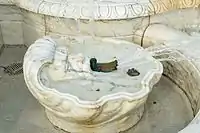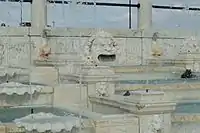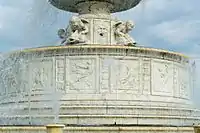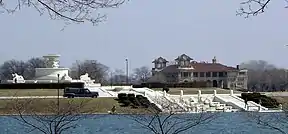James Scott Memorial Fountain
The James Scott Memorial Fountain is a monument located in Belle Isle Park, in Detroit, Michigan. Designed by architect Cass Gilbert and sculptor Herbert Adams, the fountain was completed in 1925 at a cost of $500,000.[1] The lower bowl has a diameter of 510 ft (160 m) and the central spray reaches 125 ft (38 m). The fountain honors the controversial James Scott, who left $200,000 to the City of Detroit for a fountain in tribute to himself.
| James Scott Memorial Fountain | |
|---|---|
 | |
| Artist | Cass Gilbert & Herbert Adams |
| Year | 1925 |
| Type | Marble |
| Location | Belle Isle Park Detroit, Michigan |
| 42.33506°N 82.99931°W | |
History
Scott was left a sizable fortune by his father who invested in Detroit real estate.[2] According to contemporaries, Scott gambled and told off-color stories. He was described by twentieth-century author W. Hawkins Ferry as a "vindictive, scurrilous misanthrope"[3] who attempted to intimidate his business competitors and when this was unsuccessful, he filed suit. Perhaps for these reasons, Scott died in 1910 with no heirs or colleagues and he bequeathed his estate to the City of Detroit with the condition that the fountain include a life-sized bronze statue of him.[1][2] Some accounts state that the will required that the statue be at the fountain's pinnacle.[4]
Several community and religious leaders—including Bishop Charles D. Williams[1]—spoke against accepting the bequest, saying that a person with Scott's reputation should not be immortalized in the city.[2] Mayor Philip Breitmeyer and City Council President David Heineman urged accepting the gift, saying that the city shouldn't insult any of its citizens by refusing such a generous offer.[5]
While the debate raged, Scott's fortune continued to grow, topping $1 million by the time construction commenced.[5]
Since 2018, the Detroit Grand Prix INDYCAR race has used the Fountain as its podium backdrop. Drivers are known to dip into the fountain after a race win.
Design
The monument is located in Belle Isle Park, in Detroit, Michigan. Designed by architect Cass Gilbert and sculptor Herbert Adams, the marble fountain was completed in 1925 at a cost of $500,000.[1] The lower bowl has a diameter of 510 ft (160 m) and the central spray reaches 125 ft (38 m). The final design placed Scott's statue in an inconspicuous spot behind the fountain.[1]
Movie appearances
A famous scene from the 1973 drama Scarecrow, starring Gene Hackman and Al Pacino was filmed here. In the scene shortly after learning of the death of his estranged son (though falsified by the mother), Pacino's character Francis Lionel 'Lion' Delbuchi, happily plays with a group of children before, upon uncovering a deep emotional truth, he snatches one of them up and begins to ascend the fountain. He is left catatonic in a hospital following the incident.
The fountain is also featured briefly in Anthony Mann's 1947 film noir T-Men, photographed by John Alton. Early in the film, two Treasury Agents preparing to go undercover discuss Detroit criminal gangs and gang activities while standing in front of the fountain.
Gallery
.jpg.webp) Old postcard
Old postcard Detail of one of fountain's lion figures
Detail of one of fountain's lion figures Detail of one of the eight small pools in the lower basin
Detail of one of the eight small pools in the lower basin The lower basin
The lower basin 16 separate reliefs depict life in the early days of Detroit
16 separate reliefs depict life in the early days of Detroit The Belle Isle Casino is in the background of a dry James Scott Memorial Fountain
The Belle Isle Casino is in the background of a dry James Scott Memorial Fountain
References
- Bak, Richard (1998). Detroit: A Postcard Album. Arcadia Publishing. ISBN 0752413554. P. 78.
- Austin, Dan. "James Scott Memorial Fountain". HistoricDetroit.org. Retrieved April 25, 2016.
- Sharoff, Robert (2005). American City: Detroit Architecture, 1845-2005. Wayne State University Press. ISBN 0-8143-3270-6. P. 44.
- "The James Scott Fountain". detroit1701.org. Retrieved October 25, 2010.
- Lochbiler, Don (November 7, 1997). "Detroit's Fountain of Mirth". The Detroit News. detnews.com. Archived from the original on January 21, 2013. Retrieved October 25, 2010.
Further reading
- Hill, Eric J. and John Gallagher (2002). AIA Detroit: The American Institute of Architects Guide to Detroit Architecture. Wayne State University Press. ISBN 0-8143-3120-3.
